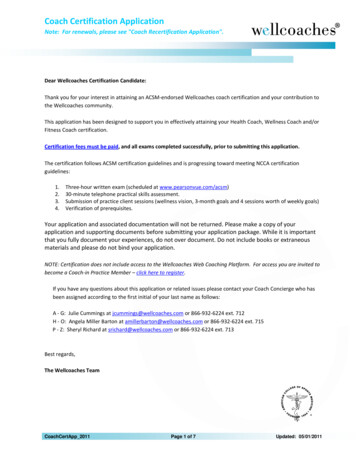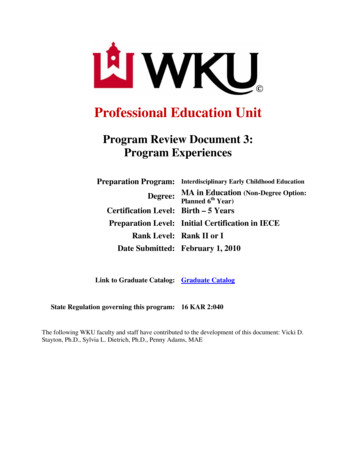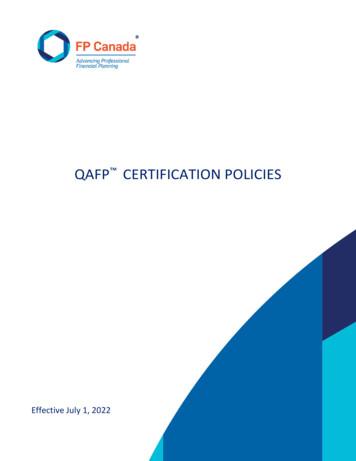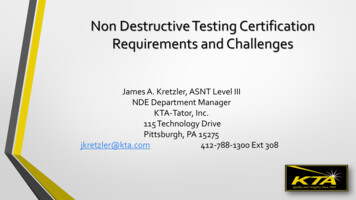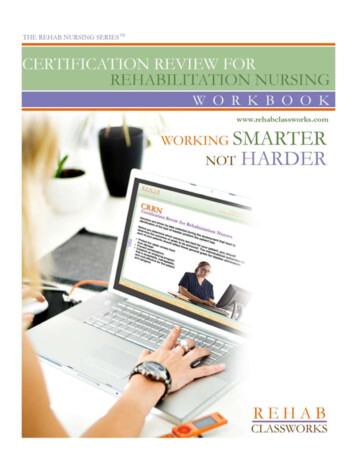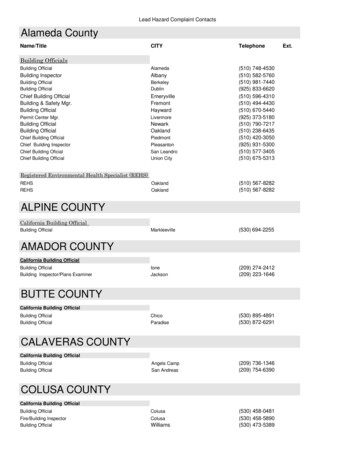
Transcription
Review of Certification in Building a Successful Sonographer Program in ChinaHannah Mason, MA, PMP, Karen Caruth, MBA, Dale R. Cyr, MBA, CAEAmerican Registry for Diagnostic Medical Sonography, Inteleos, Rockville, MD, USACorresponding author:Dale R. Cyr, MBA, CAEInteleos, 1401 Rockville Pike, Suite 600, Rockville, MD 20852, USAEmail: dale.cyr@inteleos.org
ABSTRACTBy working with local medical ultrasound experts, American Registry for Diagnostic Medical Sonography(ARDMS) of Inteleos, a non-profit certification organization, is striving to create global standards andinternational certifications in the field of diagnostic ultrasound that will improve clinical practice andpatient safety. Through eligibility and application requirements, building a proper assessment, anddetermining continuing education requirements, standards are a critical part of Inteleos’ test developmentprocess. Since 2005, Inteleos/ARDMS has been working with Chinese physicians and professionalsocieties to facilitate and promote certification and credentialing programs. Through the RegisteredPhysician in Vascular Interpretation (RPVI-China) assessment, applicants can earn the internationallyrecognized certificates in vascular ultrasound in China. Along with certification for Physicians, China’s growingpopulation and the related burden on its healthcare system as well as the rapid increases in ultrasounduse could contribute to the ideal situation for building a sonographer profession in China. Through a piloteducation and certification program for Chinese sonographers, Inteleos will work with Chinese universitiesand collaborators to build and expand the sonographer profession in China in order to reduce workload onphysicians, reduce wait times, decrease hospital costs, and provide consistently better care for theirpopulation.Key words: Certification, credentialing, ultrasound education, sonographer,
The field of ultrasound is rapidly expanding and it is important that the healthcare workforce is ready tosafely use the machines. Availability does not equal ability. How can we trust that healthcare practitionerswho will use ultrasound will be proficient in their practice? By working with local subject matter experts,organizations such as Inteleos, a non-profit certification organization, are striving to create globalstandards in healthcare that will improve patient safety.Inteleos is a is a global non-profit healthcare certification organization, that meets personnel accreditationstandards by the International Standards Organization (ISO) and develops and delivers more than 30,000ultrasound and medical imaging assessments each year. Inteleos creates standards of proficiency inmedical imaging, such as ultrasound, nuclear cardiology, and cardiac computed tomography and has over115,000 certified healthcare professionals in 70 countries.Figure 1: Outlines the assessments currently offered through Inteleos. For more information on how toapply, please visit our website at www.Inteleos.org.Importance of Standards in the Creation of International AssessmentsStandards increase quality, safety, and efficiency and benefit virtually every industry. The InternationalOrganization for Standardization (ISO) creates documents that give world-class specifications for products,services, and systems, to ensure quality, safety, and efficiency [1]. ISO has published more than 22,701international standards that impact people around the globe [2]. When there are standards in place, youcan be sure the product or process in question is safe and efficient. Inteleos credentialing programs areindependently accredited by achieving the ISO 17024 standards for personnel certification [3].Certification ProcessCreating, maintaining, and documenting standards of proficiency is more than an examination.Internationally accredited by ISO, Inteleos conducts approved test development activities which include:determining appropriate eligibility to sit the exam, building an examination that accurately reflects thescope of practice, assuring the examinations are valid and reliable, and addressing continued competencyfor lifelong learning.
When building an ultrasound assessment, anywhere in the world, one of the most important steps is topartner with local subject matter experts (SMEs). Having a strong base of reliable, local subject matterexperts is a critical component to building and maintaining the right exam for the practice, as local, on-theground practitioners have the best understanding of their specific practices.Eligibility and Application requirementsIt is important that Inteleos establish appropriate eligibility criteria that meets local or regional practitionereducation and training environments. Because there is no global standard of ultrasound practices, it isimportant that Inteleos analyze practice patterns, conduct market research and utilize input from SMEsand local regulatory groups to determine appropriate eligibility requirements. Eligibility requirementsprimarily include educational parameters along with documented clinical experience.Building a proper assessmentWhen building an assessment, it is important to ensure that certified individuals meet a standard ofproficiency, which establishes the knowledge, skills and abilities (SKAs) need to perform practice activitiesat a competent level. However, because the nuances of practice may vary from location to location; theassessment must be broad enough to establish a standard of proficiency, but customized enough toensure that it is appropriate to local practice. For this reason, it is critically important to analyze localpractice patterns. SMEs and Inteleos’ professional staff assure all examinations meet rigorouspsychometric standards of fairness, validity and reliability.Continuing educationThrough continual education, certificants can maintain life-long proficiency in the areas for which theyhave demonstrated proficiencies. Through Continuing Medical Education requirements, Inteleos is able toensure certificants’ continued engagement within the medical community and lifelong learning. (Table 1)Population and Healthcare Status in ChinaChina currently has a population of 1.41 billion [4]. As with many countries around the world, there arevariances of health outcomes in China, due to many factors, one of which is socioeconomic inequalities[5]. Of note, China is one of the most populated as well as one of the fastest aging countries in the world,giving rise to unique demands on its healthcare community.China has a high rate of non-communicable diseases (NCDs), including cardiovascular and respiratorydiseases, cancer, and diabetes. Cancer is the leading cause of death in China, with 4.3 million casesdiagnosed and 2.8 million of them causing death in 2015 [6]. This data has led the Chinese Ministry ofHealth to start a collaboration with the World Health Organization (WHO) to fight cancer in China. A specificexample is breast cancer has been on the rise in mainland China, with 260,00 new cases reported in2015, largely due to the following factors: late child- bearing, heavy workloads, smoking, and sedentarylifestyles [7].
Healthcare Workforce in ChinaIn 2015 there were around 189,000 general practitioners. The government aims to have 300,000 by2020. Given China’s population growth, even an increase such as that for general practitioners would stillresult in a decrease in per capita physicians country-wide (to 0.2 family doctors for every 1,000 people,compared with 0.14 today - see table below). That is far fewer than in many Western countries and canresult in delayed treatment due to healthcare workforce shortages [8].China is anticipated to experience a very rapid growth of ultrasound use due to growing awareness, highpatient/physician ratio, increasing healthcare expenditures, and the government’s focus on improvinghealth in the developing economies [9]. Equipment manufacturers are capitalizing on this anticipatedgrowth in China - revenue for ultrasound equipment in China was to top 1.5 billion by 2017, up a sizable65 percent from 908.8 million in 2012 [10]. A combination of new government investment, diversifyingclinical use, and changing product mix of ultrasound equipment is set to drive strong future growth of theultrasound equipment industry in China [11]. The growth sector includes smaller private hospitals,corporations that have bought imaging centers, government hospitals, and imaging centers in rural placesthat are funded through the state or through state partnerships with the private sector [12].The increase in ultrasound equipment sales, however, will not ease the strain on the existing healthcareworkforce in China. China estimates that it currently has 200,000 ultrasound physicians, and patients mayhave a wait time of up to one month for a routine ultrasound scan. Increasing the availability of equipmentwill not increase the number of proficient users; and therefore, China is exploring the addition of thesonographer profession to supplement and complement the ultrasound physician practice.Introducing Sonographers to the healthcare workforce in China is an effective way to address theworkforce shortage, patient access to ultrasound care, as the demand of ultrasound services continues togrow.Helping China build a turnkey sonographer-physician practice model and assure the creation of Chinesesonographer standards of practice will help build capacity, reduce patient wait times, and provide qualitycare for their population through certified individuals who are meeting international standards.Inteleos History of Ultrasound Assessments in ChinaPhysician Community: Registered Physician in Vascular Interpretation in China (RPVI-China) AssessmentInteleos, through the American Registry for Diagnostic Medical Sonography (ARDMS) and the Alliance forPhysician Certification and Advancement (APCA), has been working with Chinese ultrasound doctors toestablish standards of proficiency since 2005. Through the Registered Physician in Vascular Interpretation(RPVI-China) assessment, applicants can earn the highest attainable standard in vascular ultrasound inChina.
The RPVI-China assessment was developed in close partnership with the Chinese Ultrasound DoctorsAssociation (CUDA), as well as other Chinese physician subject-matter experts. The RPVI-China certificationexam assesses competency in the skills, knowledge and abilities of vascular ultrasound, for the solepurpose of further improving patient care and safety in China. With pilots beginning in 2008 and theassessment formally launched in 2014, now over 600 Chinese ultrasound doctors (Figure 2) have takenthe assessment. Inteleos remains connected with the ultrasound doctors in China and engaged indiscussions with the community regarding relevant future ultrasound assessments.Figure 2: Exam Volumes for RPVI-China 2014-2017Sonographer Education and Certification Program – a PilotIn partnership with Jefferson University, in Philadelphia, USA, and the West China Medical School ofSichuan University, Inteleos has created a pilot education and certification program for Chinesesonographers. Helping China build a turnkey sonographer-physician practice model and assuring thecreation of Chinese sonographer standards of practice will help build capacity, reduce wait times, andprovide consistently better care for their population. Jefferson University and Inteleos are in a uniqueposition to help guide and expand the implementation of this emerging profession.To meet the globally-recognized standard of care that United States sonographers have achieved, Chinahas modeled its new sonographer programs to culminate in taking the ARDMS assessments.Sonographers who successfully pass the ARDMS assessments will receive the same credentials assonographers practicing in the United States and will be globally recognized for their expertise insonography.Inteleos and Jefferson University have been working closely with West China Medical School of SichuanUniversity and are now expanding the outreach to other sonography programs including, ShanghaiUniversity of Medicine and Health Sciences and Hangzhou Medical College, in order to cultivate acommunity of trained sonographers in China. Through these programs, faculty from Jefferson Universitywork with Chinese sonographer educational programs to assure standardized education and training isdeveloped and maintained. Students are taught with a curriculum that contains the outline from Jeffersonon sonography, but has additional courses typical for a Chinese University setting.After completing their coursework and clinical hours, participating students are eligible to sit for ISOaccredited certifications such as the Registered Diagnostic Medical Sonographer (RDMS), RegisteredDiagnostic Cardiac Sonographer (RDCS), Registered Vascular Technologist (RVT) and RegisteredMusculoskeletal Sonographer (RMSKS) credentials under international standards as the certifying body.Affiliated programs are eligible to apply for the ARDMS certifications.
Participating programs are not only eligible to sit for the ARDMS assessments, but are also engaged withInteleos and Jefferson University’s Sonographer Education Network. While beginning in China, thispartnership model could be replicated on a global basis, especially in developing ultrasound healthcareenvironments.In summary, China’s growing population and the related burden on its healthcare system, along with therapid increases in ultrasound use, contribute to the ideal situation for the growth of a sonographerprofession in China. Clinically proficient sonographers, adhering to globally-recognized standards ofpractice, can reduce workload on physicians while simultaneously increase the access to qualityultrasound care to patients and reduce costs to hospital systems. Through working with Jefferson, WestChina Medical School of Sichuan University, and other partners, Inteleos hopes to expand its partnershipwith the China medial community to build a world-class sonographer program to enhance patient care andsafety in China.Conflict of Interest: The authors are employees of Inteleos: Hannah Mason, MA, PMP, Manager of BusinessDevelopment, Inteleos, Karen Caruth, MBA, Chief Business Development Officer, Inteleos, and Dale R. Cyr,MBA, CAE, Executive Director and CEO, Inteleos.References1. https://www.iso.org/standards.html2. https://www.iso.org/about-us.html3. http://www.inteleos.org4. a-population/5. 66/6. http://en.nhfpc.gov.cn/2017-11/02/c 72597.htm7. http://en.nhfpc.gov.cn/2017-09/15/c 72528.htm8. a-needs-many-more-primary-care9. ortunity/4657886310. ore-60-percent-within-fiv11. ore-60-percent-within-fiv12. http://www.auntminnie.com/index.aspx?sec ser&sub def&pag dis&ItemID 110035
By working with local medical ultrasound experts, American Registry for Diagnostic Medical Sonography (ARDMS) of Inteleos, a non-profit certification organization, is striving to create global standards and international certifications in the field of diagnostic ultrasound that will improve clinical practice and patient safety.


